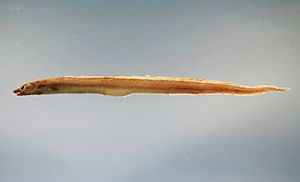American conger facts for kids
Quick facts for kids American conger |
|
|---|---|
 |
|
| Conservation status | |
| Scientific classification | |
| Synonyms | |
|
The American conger (Conger oceanicus) is a type of eel. People also call it the conger, dog eel, poison eel, or sea eel. This fish lives in the ocean, mostly in the western Atlantic Ocean. You can find it from Cape Cod in Massachusetts down to northeastern Florida in the United States. It also lives in the northern Gulf of Mexico. Sometimes, it is seen near the island of St. Helena and off the coast of Nova Scotia in Canada. This eel is usually dark grayish. It can grow to be about 6.5 feet (2 meters) long and weigh more than 40 kilograms (90 pounds).
Contents
What the American Conger Looks Like
The American conger is a very long, cylinder-shaped fish. It can grow over 2 meters (6.5 feet) long and weigh more than 40 kilograms (90 pounds). But most American congers are about 1 meter (3 feet) long. Its upper jaw sticks out a bit more than its lower jaw.
The fin on its back, called the dorsal fin, starts right behind its front fins. This fin runs all the way to the tip of its tail. The fin on its belly, called the anal fin, is also very long. Both the dorsal and anal fins join together at the tail. The top part of the eel's body is dark gray. Its belly side is whitish. The edges of its dorsal and anal fins are dark.
Where the American Conger Lives and What It Eats
This eel lives on the bottom of the ocean. It hunts for food mostly at night. The American conger mainly eats other fish. But it also enjoys eating molluscs (like clams or snails) and crustaceans (like crabs or shrimp).
American congers travel long distances. Young eels might live in river mouths for a while. However, unlike some other eels, they do not spend time in fresh water. Adult American congers leave the shallow waters near the coast in the summer. They swim across the Gulf Stream to the Sargasso Sea. This area is north of the Bahamas. Here, they lay their eggs in floating patches of seaweed called sargassum. This happens in the autumn and winter. After laying eggs, the adult eels are thought to die.
The baby eels are called leptocephali. They hatch from the eggs and float away from the seaweed. The Gulf Stream then carries them along. They go through four different stages as larvae. When they are about 10 centimeters (4 inches) long, they change into young eels called elvers. These elvers leave the Gulf Stream and swim towards the coast. They then live on the seabed and might even go into river mouths. Because they are good at hiding, it is hard to study them at this stage.
Is the American Conger in Danger?
The American conger lives in many places. You can find it in both shallow and deep waters over the continental shelf. It is a common fish, and scientists have not found any major threats to it. Because of this, the International Union for the Conservation of Nature says its conservation status is "least concern". This means it is not currently in danger of disappearing.
People do fish for the American conger. Some people catch them for fun. Others catch them by accident while fishing for other things. They are caught using hooks and lines, in fish traps, or by dragging nets across the seabed. The State of Maine carefully controls how many elvers (young eels) can be caught. Licenses to catch elvers are given out through a special lottery system. In the past, people used to fish for American congers for money. Their meat is good to eat, and it is often smoked before people eat it.
See also
 In Spanish: Conger oceanicus para niños
In Spanish: Conger oceanicus para niños


